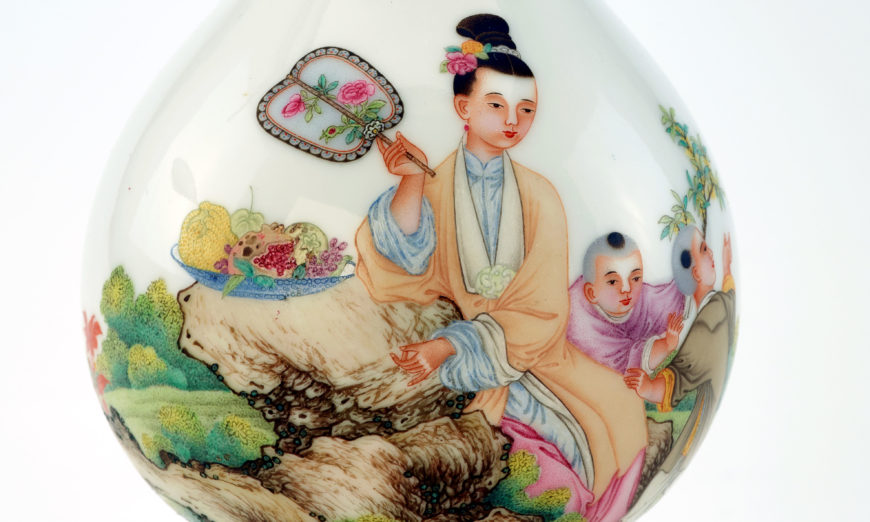
Vase of bottle shape with “garlic” mouth, Qing dynasty or possibly modern, Qianlong reign, 1736–1795, or possibly early 20th century, Jingdezhen ware, porcelain with enamels over clear, colorless glaze; ivory stand, China, Jiangxi province, Jingdezhen, 17.2 x 9.5 cm (Freer Gallery of Art, Smithsonian Institution, Washington, DC: Purchase — Charles Lang Freer Endowment, F1954.127a-e)
This is a beautiful porcelain vase. It has a rounded body and slim, tall neck. The mouth resembles a bulb of garlic and is decorated with a stylized leaf pattern. The painting on the vase depicts a lady and two children in a blooming garden. The woman sits on a rock, holding a fan in her right hand. Next to her is a dish of pomegranates that symbolize fertility. One of the boys holds a branch of Osmanthus. The Chinese name for Osmanthus is a homophone for “noble.” As the plant blooms during the same month as the imperial examinations in the fall, it also signifies literary success. These two concepts reveal the painting as symbolic for the wish to bear high-ranking sons. The two-sentence poem sets an autumnal mood: “The infinite moon is born in the branches/When blossoms are at their fullest, autumn naturally has come.”

Vase of bottle shape with “garlic” mouth (detail), Qing dynasty or possibly modern, Qianlong reign, 1736–1795, or possibly early 20th century, Jingdezhen ware, porcelain with enamels over clear, colorless glaze; ivory stand, China, Jiangxi province, Jingdezhen, 17.2 x 9.5 cm (Freer Gallery of Art, Smithsonian Institution, Washington, DC: Purchase — Charles Lang Freer Endowment, F1954.127a-e)
The vase was potted in Jingdezhen where imperial kilns of the Ming (1368–1644) and Qing (1644–1911) dynasties were located. It was then sent north to Beijing to be decorated by court painters. The painting on the vase was minutely drawn in fine enamel (glass paste) colors. The modeling of the figures (especially the faces and hands), as well as the rendering of the and shrubs in the background, reveal an awareness of European painting techniques. This reflects the influence of Jesuit painters such as Giuseppe Castiglione (1688–1766) who were active at the court.

Vase of bottle shape with “garlic” mouth (detail), Qing dynasty or possibly modern, Qianlong reign, 1736–1795, or possibly early 20th century, Jingdezhen ware, porcelain with enamels over clear, colorless glaze; ivory stand, China, Jiangxi province, Jingdezhen, 17.2 x 9.5 cm (Freer Gallery of Art, Smithsonian Institution, Washington, DC: Purchase — Charles Lang Freer Endowment, F1954.127a-e)
The fine quality of the porcelain and delicate painting details both suggest that the vase was made for and used by the court. The four-character Qianlong (reigned 1736–95) mark on the bottom of the vase reinforces this conclusion.

Ding Guanpeng (active 1726-after 1770), Palace Ladies and Children, Qing dynasty, mid-18th century, ink and color on paper, China, 17.4 x 93.5 cm (Freer Gallery of Art, Smithsonian Institution, Washington, DC: Transfer from the United States Customs Service, Department of the Treasury, F1980.126)
During the reign of the Qianlong emperor, imperial paintings and porcelain frequently shared a palette and similar subjects, as seen in this vase and a painting by the Qing court painter Ding Guanpeng (active 1726–after 1770). Vases with this type of painting were made in a very small number, so there are relatively few comparisons.
 This resource was developed for Teaching China with the Smithsonian, made possible by the generous support of the Freeman Foundation
This resource was developed for Teaching China with the Smithsonian, made possible by the generous support of the Freeman Foundation

